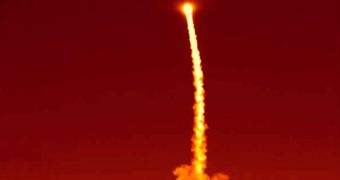NASA's new mission to scout and map the Universe, the Wide-field Infrared Survey Explorer (WISE), launched from the Vandenberg Air Force Base (VAFB), in California, on December 14. After having successfully reached the orbit, the new satellite has begun the commissioning and testing phases of its mission. These operations are scheduled to last for about a month. A crucial step in WISE's time line is the point where it jettisons its lens cap, a move that is usually considered to be very dangerous.
Less than a day after launch, WISE managed to acquire the Sun's position, and aligned its solar panel accordingly. Engineers are currently preparing the satellite's instruments for the months of missions ahead. According to mission planners, the spacecraft is scheduled to scan the Universe in highly detailed photos in the infrared region of the electromagnetic spectrum. Several hundred million objects will be surveyed during this time, they add, and the advanced optical systems on WISE will ensure that one of the most complex and detailed maps of the IR Cosmos is produced.
“Now that WISE is steadily perched in the vacuum of space, it will no longer need the instrument cover; in fact, space will provide an even better vacuum. Engineers are preparing to pop the cover by making sure the pointing-control system is functioning properly. Once everything has been checked out, they will send a signal to fire pyrotechnic devices, releasing nuts that are clamping the cover shut. Three springs will then push the lid away and into an orbit closer to Earth than that of the spacecraft,” engineers at the NASA Jet Propulsion Laboratory (JPL), in Pasadena, California, say.
The lens cap, which hides the 40-centimeter telescope and its four infrared detectors, was necessary to prevent light and heat contamination inside the satellite. The cryostat cooling the instruments is planned to reach a temperature lower than 190 Kelvin (minus 83 degrees Celsius, or minus 117 degrees Fahrenheit). The lens was necessary because unplanned pointing at the Earth or the Sun would have decreased the cryostat's life span.
JPL manages WISE for NASA's Science Mission Directorate, in Washington DC. The principal investigator, Edward Wright, is based at the University of California in Los Angeles (UCLA). The mission was competitively selected under NASA's Explorers Program, which is managed by the Goddard Space Flight Center, in Greenbelt, Maryland.

 14 DAY TRIAL //
14 DAY TRIAL //